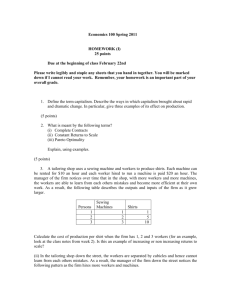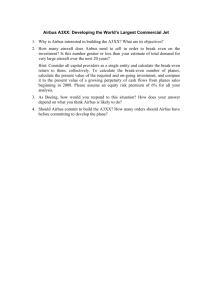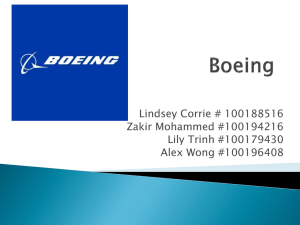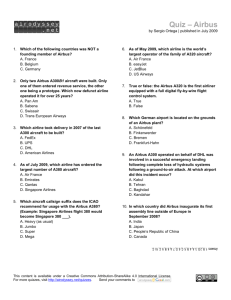Case Study 39 Airbus vs. Boeing
advertisement
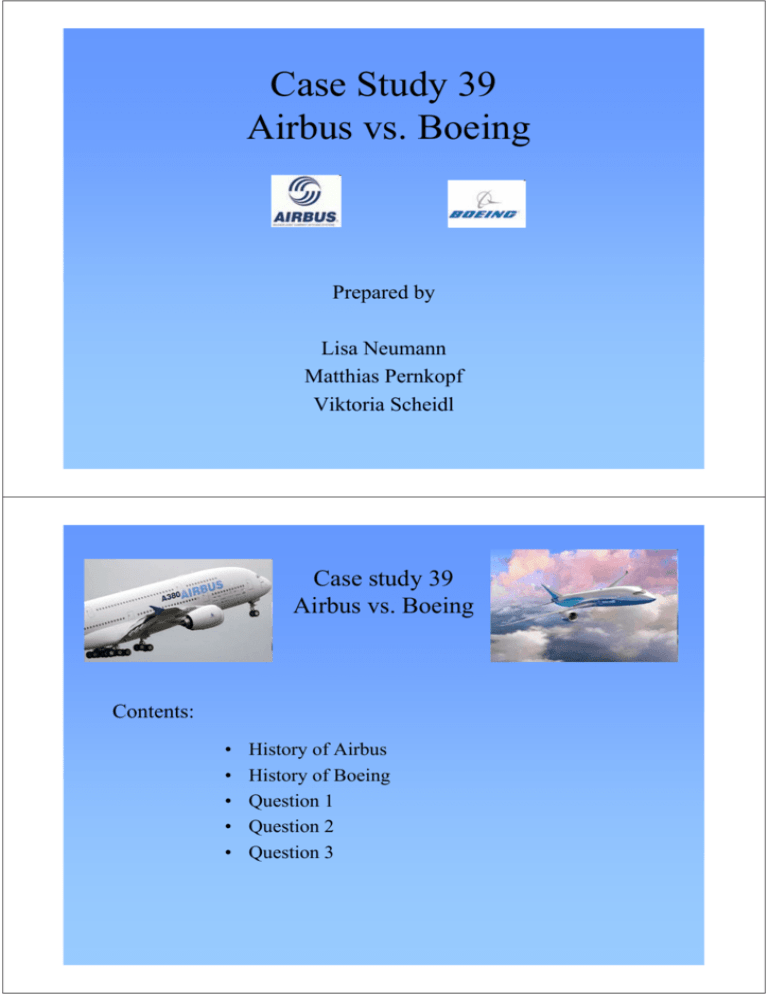
Case Study 39 Airbus vs. Boeing Prepared by Lisa Neumann Matthias Pernkopf Viktoria Scheidl Case study 39 Airbus vs. Boeing Contents: • • • • • History of Airbus History of Boeing Question 1 Question 2 Question 3 History of Airbus •1970: Airbus was formed as European consortium of French and German companies •Spain companies joined the consortium •1979: British Aerospace joined Airbus Industrie. •Each of the four partners operated as national companies •Airbus developed a deserved reputation •2001: Airbus became a single fully integrated company •2004: company had overtaken its main rival •In January 2005 the world’s largest and most advanced passenger aircraft appeared, the A380 •Airbus is one of the world’s leading aircraft manufacturers History of Boeing • was established by William Boeing • the most successful company of U.S. •1916: built their first plane •1917: the Boeing Airplane Company arose. •During World War I, the Navy needed training airplanes. • Boeing leading designer of military aircraft. •1927: Boeing created an airline, named Boeing Air Transport (BAT) •1958:The US became a leader in commercial jet manufacture. •2001: Boeing is focused on 787 Dreamliner •Boeing lost ground to Europe’s Airbus and lost its position as market leader in 2003. • 2006 sets another new Boeing record for total commercial orders in a single year. Question 1 Why is the aircraft manufacturing industry dominated by only two companies?Discuss the barriers to entry that exist in the market. The Porter model of competitive industy structure Key entry barriers include: •Economies of scale •Capital requirements •Switching costs •Access to distribution •Expected retaliation Only two companies •Each consist of many small firms and represent the U.S. or Europe •Each have total power in their continent •No other company is able to compete •They are large firms which can generally produce goods at lower costs than small, inexperienced firms. Question 2 Critically appraise Airbus‘s decision to enter the super-jumbo market by launching ist double-decker A-380 plane. PROS & CONS PROS: •Large customer-growth expected (3 x) •Airlines’ porfit: lower costs (f.e. fuel,…) CONS: Volatile Market •Many large airline carriers are facing bankruptcy •Market susceptible to environmental shoks (f.e.: World Trade Center attacks of 2001, SARS,..) •A porbable boom is highly connected with a growth in: - the low cost sector - demand in the Asien markets - Airlines demanding more fuel efficiancy Duopoly makes it difficult to gain status in the super – jumbo market •Airbus has great success and reputation in the mid-size market. •Iconic status of Boeings 747 and 777 - Marketholder for decades High financial risks •Huge amount of capital tied up in development •Delays produce extraordinary penalty-costs •Airbus needs 250 sales orders to break even on the project •Airlines have doubts concerning their profits - Experts are not sure if the the volume in terms of capacity (555 passengers) leads to profit for Airlines Pan-European structure could cause problems •Delays •National governments are highly involved Question 3 Develope a competitive marketing strategy for Airbus in the wake of Boeing´s success with ist new Dreamliner 787 jet. What is a marketing strategy? A marketing strategy is a process that allows an organisation to concentrate its limited recources on the greatest opportunities to increase sales and achieve a competetive advantage. Current strategy of Airbus •increase market share to 50% •increase the slice of the large wide-body aircraft market •garner more orders than Boeing and deliver 490 aircrafts per year •compete boeing´s 747 and test their dominance •compete boeing´s 777 and 787 with A350 long-hauld mid-siced fuel-efficient plane Possible Strategies •do nothing •concentrate on the mid-size jet market (A350) •cancel plans for A350 complete •concentrate on A380 •develope a cross platform Analysis of Boeing •concentrate on the mid-size, long range fuel officient jets for the global market •made environment friendly 777 and 787 a key selling point Æhotseller for boeing •rise in demand due to the popularity of its two fuelefficient long-range jets. •no jet compared to A380 Airbus vs. Boeing •Airbus should concentrate on A380 -no competitors on that stage -they´ve allready spent a huge amount of money for developement ($12 billion) -success essential for Airbus •hope that it will dominate the sector for the next 20 years, like Boeing 747 How to achieve that goal •Create a competitive advantage by - satisfying customers - make it a unique experience flying with the biggest airplane of the world, by offering special services - create greater value than the competitor •differentiation! A380 advantages •new market •capacity of 555 passengers •greater flexibility in setting prices •only 20% more fuel use than Boeing •special features for customers - casino - virtuel presentation room - boutik - more comftable flight Airbus´ special look
